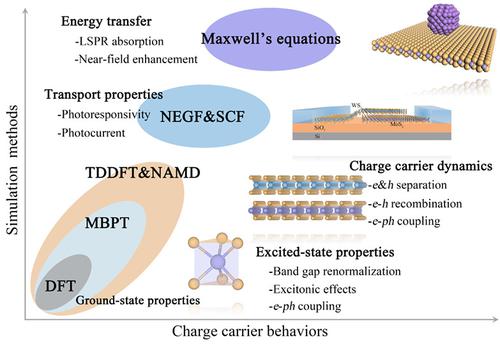当前位置:
X-MOL 学术
›
WIREs Comput. Mol. Sci.
›
论文详情
Our official English website, www.x-mol.net, welcomes your
feedback! (Note: you will need to create a separate account there.)
Photoexcited charge carrier behaviors in solar energy conversion systems from theoretical simulations
Wiley Interdisciplinary Reviews: Computational Molecular Science ( IF 16.8 ) Pub Date : 2019-08-16 , DOI: 10.1002/wcms.1441 Wei Wei 1 , Baibiao Huang 1 , Ying Dai 1
Wiley Interdisciplinary Reviews: Computational Molecular Science ( IF 16.8 ) Pub Date : 2019-08-16 , DOI: 10.1002/wcms.1441 Wei Wei 1 , Baibiao Huang 1 , Ying Dai 1
Affiliation

|
Solar energy bears great potential in the substitution of conventional fossil fuels to enable a sustainable world. In order to harness and use solar energy, photocatalytic and photovoltaic systems made of semiconductor materials have been developed to convert sunlight into energy (electricity) based on the photoelectrochemical effects. Photoelectric events are related with the light–energy (electricity) conversion process, including photon absorption, photoexcited charge carrier separation and recombination, charge carrier transport, and photocurrent generation, as well as electron plasmonic resonance. We focus on the recent state‐of‐the‐art simulation methods correspondingly mimicking these photogenerated charge carrier behaviors, taking electron–phonon, electron–exciton, and exciton–exciton interactions into account. Results can be obtained from the standard density function theory (DFT) for ground‐state properties, many‐body perturbation theory for band gap renormalization and optical absorption, time‐domain DFT in combination with nonadiabatic molecular dynamics for photoexcitation dynamics, nonequilibrium Green's function and self‐consistent theory for charge carrier transport properties, and classical Maxwell's equations in discrete dipole approximation for localized surface plasmon resonance absorption and near‐field enhancement. In combination of the results from these simulation methods, a complete and consistent picture describing the fundamental photoelectric process in light–energy (electricity) conversion could be obtained. Simulation results offer guidelines for experimental efforts and provide new basic insights into the underlying mechanisms and the design principles for next‐generation photocatalytic and photovoltaic devices of high solar light utilization efficiency.
中文翻译:

从理论模拟看太阳能转换系统中的光激发电荷载流子行为
太阳能在替代常规化石燃料方面具有巨大潜力,可实现可持续发展的世界。为了利用和利用太阳能,已经开发了由半导体材料制成的光催化和光伏系统,以基于光电化学效应将太阳光转换成能量(电)。光电事件与光能(电)转换过程有关,包括光子吸收,光激发的电荷载流子分离和复合,电荷载流子传输,光电流产生以及电子等离子体共振。我们关注最新的最先进的模拟方法,这些方法相应地模仿了这些光生电荷载流子的行为,并考虑了电子-声子,电子-激子和激子-激子的相互作用。可以从用于基态特性的标准密度函数理论(DFT),用于带隙重归一化和光吸收的多体微扰理论,时域DFT与用于光激发动力学的非绝热分子动力学,非平衡格林函数和电荷载流子传输特性的自洽理论,以及离散偶极子近似中的经典麦克斯韦方程,用于局部表面等离子体激元共振吸收和近场增强。结合这些模拟方法的结果,可以获得完整一致的图像,该图像描述了光能(电)转换中的基本光电过程。
更新日期:2019-08-16
中文翻译:

从理论模拟看太阳能转换系统中的光激发电荷载流子行为
太阳能在替代常规化石燃料方面具有巨大潜力,可实现可持续发展的世界。为了利用和利用太阳能,已经开发了由半导体材料制成的光催化和光伏系统,以基于光电化学效应将太阳光转换成能量(电)。光电事件与光能(电)转换过程有关,包括光子吸收,光激发的电荷载流子分离和复合,电荷载流子传输,光电流产生以及电子等离子体共振。我们关注最新的最先进的模拟方法,这些方法相应地模仿了这些光生电荷载流子的行为,并考虑了电子-声子,电子-激子和激子-激子的相互作用。可以从用于基态特性的标准密度函数理论(DFT),用于带隙重归一化和光吸收的多体微扰理论,时域DFT与用于光激发动力学的非绝热分子动力学,非平衡格林函数和电荷载流子传输特性的自洽理论,以及离散偶极子近似中的经典麦克斯韦方程,用于局部表面等离子体激元共振吸收和近场增强。结合这些模拟方法的结果,可以获得完整一致的图像,该图像描述了光能(电)转换中的基本光电过程。











































 京公网安备 11010802027423号
京公网安备 11010802027423号